For Complete IIPM Article, Click on IIPM Article
Source : IIPM Editorial, 2006
An IIPM and Management Guru Professor Arindam Chaudhuri's Initiative
 DRIVING HOMO... ER, HOME THE POINT OF BOND'S BONDS
DRIVING HOMO... ER, HOME THE POINT OF BOND'S BONDS e too many of the super- babes.
e too many of the super- babes. the epicenter of the colossal change brought in the Indian two-wheeler industry, so much so that today their company owns a staggering 52% of the Indian two-wheeler market, and is the world’s single largest two-wheeler company by volumes. Today, the erstwhile bicycle company has six different models in its range of nine product diversifications with the Splendor becoming the most popular motorcycle of all times (across the globe) selling more than a smashing 1.3 million units in the year 2002.
the epicenter of the colossal change brought in the Indian two-wheeler industry, so much so that today their company owns a staggering 52% of the Indian two-wheeler market, and is the world’s single largest two-wheeler company by volumes. Today, the erstwhile bicycle company has six different models in its range of nine product diversifications with the Splendor becoming the most popular motorcycle of all times (across the globe) selling more than a smashing 1.3 million units in the year 2002. with finer portability is what Samsung is offering you this time. Samsung’s P310 is all about style with a chrome and black exterior. The handset’s novel design is all set to lure professionals who believe in creating a chic style statement. Priced at just Rs.21,499, what’re you waiting for? Grab this slim gadget and carry it with class!
with finer portability is what Samsung is offering you this time. Samsung’s P310 is all about style with a chrome and black exterior. The handset’s novel design is all set to lure professionals who believe in creating a chic style statement. Priced at just Rs.21,499, what’re you waiting for? Grab this slim gadget and carry it with class! icket team’s jersey outside his window with tears in his eyes. The jersey goes flying when an aircraft passes over it. Then with a pant of guilt of throwing the Indian jersey, he ran to check out its whereabouts. He feels relieved when he sees the jersey land in a small boy’s hand. The ad ends with smiling face of the old man when he hears the boy screaming ‘Phir Aayega India’.
icket team’s jersey outside his window with tears in his eyes. The jersey goes flying when an aircraft passes over it. Then with a pant of guilt of throwing the Indian jersey, he ran to check out its whereabouts. He feels relieved when he sees the jersey land in a small boy’s hand. The ad ends with smiling face of the old man when he hears the boy screaming ‘Phir Aayega India’. 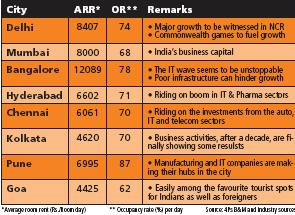 ent, and plans to roll it out across the country. Raymond Bickson, MD & CEO, IHC says, “Priced at Rs.950 for a single room and at Rs.1,175 for a double room, Ginger hotels have created a new category in the domestic hospitality landscape.” Foreign players are also invading this territory. Accor, Best Western and Days Inn are some of the players looking to go for a kill. Hoteliers are eying budget segment as a stream to diversify their hotel business, with the Indian chains not only steaming up things locally, but also in the global markets. Unlike the other industries, overseas invasion by the Indian hoteliers was initiated almost five decades back.
ent, and plans to roll it out across the country. Raymond Bickson, MD & CEO, IHC says, “Priced at Rs.950 for a single room and at Rs.1,175 for a double room, Ginger hotels have created a new category in the domestic hospitality landscape.” Foreign players are also invading this territory. Accor, Best Western and Days Inn are some of the players looking to go for a kill. Hoteliers are eying budget segment as a stream to diversify their hotel business, with the Indian chains not only steaming up things locally, but also in the global markets. Unlike the other industries, overseas invasion by the Indian hoteliers was initiated almost five decades back. make merry by digging deep into this 3-million passenger market to and from India, a market which is slated to grow by 10% per year. Well the competition seems to be very much on the cards as another airliner from India, Kingfisher Airlines, is also gunning to follow suit as reported by sources. But what these hitherto domestic competitors can do in the international aviation arena, remains to be seen. For Indian flyers, more and more options are opening up. So, ladies and gentlemen, please fasten your seat belts!!
make merry by digging deep into this 3-million passenger market to and from India, a market which is slated to grow by 10% per year. Well the competition seems to be very much on the cards as another airliner from India, Kingfisher Airlines, is also gunning to follow suit as reported by sources. But what these hitherto domestic competitors can do in the international aviation arena, remains to be seen. For Indian flyers, more and more options are opening up. So, ladies and gentlemen, please fasten your seat belts!! magine a world where homes have no telephones, televisions or refrigerators, where the people dress as plainly as possible, ensuring none of their clothes have any prints or pleats, tailored to attract absolutely no attention to the human contours. No man sports a moustache here as it’s a symbol of male pride; no woman wears any jewellery or cosmetics, even on the wedding day, to keep vanity at bay. Farmers don’t employ any mechanical equipment, not even tractors, so that they don’t consider increasing their lands and thus create an imbalance in society. No Porsche or Lamborghini speeds down the lanes of their towns, instead horse-drawn buggies set the pace of the neighbourhood… Sounds like a fruitless flight of fancy of a retro-dreamer?
magine a world where homes have no telephones, televisions or refrigerators, where the people dress as plainly as possible, ensuring none of their clothes have any prints or pleats, tailored to attract absolutely no attention to the human contours. No man sports a moustache here as it’s a symbol of male pride; no woman wears any jewellery or cosmetics, even on the wedding day, to keep vanity at bay. Farmers don’t employ any mechanical equipment, not even tractors, so that they don’t consider increasing their lands and thus create an imbalance in society. No Porsche or Lamborghini speeds down the lanes of their towns, instead horse-drawn buggies set the pace of the neighbourhood… Sounds like a fruitless flight of fancy of a retro-dreamer?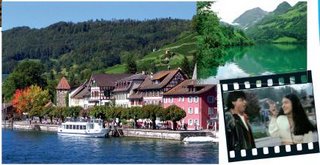 me, and their banks, you guessed it – perfect. It’s impossible to imagine anyone sad, poor or dead in these spectacular settings. No wonder Yash Chopra has been ‘banking’ on Switzerland’s gorgeous locales to make his sugary romances look as rich and delectable as Swiss chocolate. Set amidst sprawling lush green mountains and snowy summits on one hand and Lake Thun on the other, the town of Thun in central Switzerland is one of the highly ranked destinations amongst film makers. Opportunities unlimited for water sports, the largest lake in the Swiss country has venues enough for the wet-and-the-wild narratives!
me, and their banks, you guessed it – perfect. It’s impossible to imagine anyone sad, poor or dead in these spectacular settings. No wonder Yash Chopra has been ‘banking’ on Switzerland’s gorgeous locales to make his sugary romances look as rich and delectable as Swiss chocolate. Set amidst sprawling lush green mountains and snowy summits on one hand and Lake Thun on the other, the town of Thun in central Switzerland is one of the highly ranked destinations amongst film makers. Opportunities unlimited for water sports, the largest lake in the Swiss country has venues enough for the wet-and-the-wild narratives! me Minister Manmohan Singh seems to have found a new mantra to tackle suicides by indebted farmers of India. On October 18, while addressing the second Agricultural Summit in New Delhi, the PM initiated a debate over the possibility of bringing the money lenders under the fold of governmental regulations when he said, “What do farmers need – a lower rate of interest or a reliable access to credit at a reasonable rate? Do we need to bring in money lenders under some form of regulation?” However, Dr. Singh seems to have ignored the fact that the recent spate of suicides by farmers in parts of southern India has got very little to do with either reliability or the rate of interest on credit lent by the private lenders.
me Minister Manmohan Singh seems to have found a new mantra to tackle suicides by indebted farmers of India. On October 18, while addressing the second Agricultural Summit in New Delhi, the PM initiated a debate over the possibility of bringing the money lenders under the fold of governmental regulations when he said, “What do farmers need – a lower rate of interest or a reliable access to credit at a reasonable rate? Do we need to bring in money lenders under some form of regulation?” However, Dr. Singh seems to have ignored the fact that the recent spate of suicides by farmers in parts of southern India has got very little to do with either reliability or the rate of interest on credit lent by the private lenders. e is busy saving face after an embarrassing corporate spying scandal and the other is, most probably, having nightmares of burning laptop batteries nowadays. But neither the HP CEO, Mark Hurd, nor the Dell Chairman, Michael Dell, can let these impediments come in the way of their larger vision, that is, to be the undisputed leaders in the global computing industry. As per the latest figures from IDC with regard to global PC shipments for the quarter ending September 2006, HP emerged as the market leader (albeit by a slender margin) after gap of three years. PC shipments for HP increased by 15.1% while Dell recorded its worst ever performance, exhibiting a minuscule growth rate of 3.6%. “We gained share without sacrificing margins and continue to execute well against our long-term plan.
e is busy saving face after an embarrassing corporate spying scandal and the other is, most probably, having nightmares of burning laptop batteries nowadays. But neither the HP CEO, Mark Hurd, nor the Dell Chairman, Michael Dell, can let these impediments come in the way of their larger vision, that is, to be the undisputed leaders in the global computing industry. As per the latest figures from IDC with regard to global PC shipments for the quarter ending September 2006, HP emerged as the market leader (albeit by a slender margin) after gap of three years. PC shipments for HP increased by 15.1% while Dell recorded its worst ever performance, exhibiting a minuscule growth rate of 3.6%. “We gained share without sacrificing margins and continue to execute well against our long-term plan. it comes to American companies losing billions of dollars of business, they had been successful to force their Presidents to make sure that sanctions become just a lip service, whereas everything else goes on as usual. Otherwise has anyone ever wondered whether it has ever happened before (or later) in the American history that even when sanctions remained, the American president (Read: Bill Clinton) was in India and busy dancing with the pretty women of Rajasthan, to keep his Indian counterparts happy? Well that’s the magic and lure of an $800 billion economy. Just keep going to keep them at bay.
it comes to American companies losing billions of dollars of business, they had been successful to force their Presidents to make sure that sanctions become just a lip service, whereas everything else goes on as usual. Otherwise has anyone ever wondered whether it has ever happened before (or later) in the American history that even when sanctions remained, the American president (Read: Bill Clinton) was in India and busy dancing with the pretty women of Rajasthan, to keep his Indian counterparts happy? Well that’s the magic and lure of an $800 billion economy. Just keep going to keep them at bay. s that remain unanswered or perhaps answered but not quite... the oft -repeated ‘who we really are and where do we come from?’ emerges to the forefront yet again with a 3.3 million old find. With this discovery, scientists may have stumbled upon what would take them closer to unravelling the age old mystery – origins of the Modern Man. Africa for all its wild beauty and splendour is also believed to be the cradle of all civilisations and the latest link in the theory of evolution chain is the discovery of a near-intact skeleton of a three-year old female human ancestor that lived one hundred and fifty years before the famed ‘Lucy’ of the same species. The discovery hasn’t come without its share of grind for the scientists involved in the project.
s that remain unanswered or perhaps answered but not quite... the oft -repeated ‘who we really are and where do we come from?’ emerges to the forefront yet again with a 3.3 million old find. With this discovery, scientists may have stumbled upon what would take them closer to unravelling the age old mystery – origins of the Modern Man. Africa for all its wild beauty and splendour is also believed to be the cradle of all civilisations and the latest link in the theory of evolution chain is the discovery of a near-intact skeleton of a three-year old female human ancestor that lived one hundred and fifty years before the famed ‘Lucy’ of the same species. The discovery hasn’t come without its share of grind for the scientists involved in the project. f Honour’ at the Frankfurt Book Fair twice (India was Guest of Honour twenty years ago). In those twenty years, the Indian book market has changed beyond recognition with 80,000 new books on the market each year.” “…the title translates to lots of space devoted not just to Indian publishing, but India culture… One of the highlights will be the Saturday evening screening of Kabhi Alvida Naa Kehna (Never Say Goodbye), starring Bollywood household name, Shah Rukh Khan. The fim has been directed by Karan Johar who will attend its screening in Frankfurt on Saturday, October 7. Leading fi lm director, Mira Nair, will speak and take questions about her new film Th e Namesake on Sunday, October 8. Audiences will have the chance to enjoy a viewing of the USA-based director’s work on Friday, October 6. On Sunday, October 8, the small Book Fair Cinema is entirely dedicated to Bollywood with screenings of popular films including Disco Dancer, Rang de Basanti and Parineeta..”
f Honour’ at the Frankfurt Book Fair twice (India was Guest of Honour twenty years ago). In those twenty years, the Indian book market has changed beyond recognition with 80,000 new books on the market each year.” “…the title translates to lots of space devoted not just to Indian publishing, but India culture… One of the highlights will be the Saturday evening screening of Kabhi Alvida Naa Kehna (Never Say Goodbye), starring Bollywood household name, Shah Rukh Khan. The fim has been directed by Karan Johar who will attend its screening in Frankfurt on Saturday, October 7. Leading fi lm director, Mira Nair, will speak and take questions about her new film Th e Namesake on Sunday, October 8. Audiences will have the chance to enjoy a viewing of the USA-based director’s work on Friday, October 6. On Sunday, October 8, the small Book Fair Cinema is entirely dedicated to Bollywood with screenings of popular films including Disco Dancer, Rang de Basanti and Parineeta..” efineries greener (mango trees) has turned out to be a major money minting machine for Reliance Industries. Surprisingly ,mangoes are fetching higher profit margins than the company’s core products. It started last year when Reliance industries planted 470acres of mango plantation, largest in Asia; and produced some 387 tonnes of the juicy fruits. Around three tones of the consignment was purchased by London-based tony store chain, Harrods. The chain is selling the mangoes in both townships and some major store chains within the country and demands100 tonnes by next year. The mangoes are sold by Reliance Industries for Rs.40 per kg, which are then sold by foreign stores for as high as Rs.2,400 per dozen.
efineries greener (mango trees) has turned out to be a major money minting machine for Reliance Industries. Surprisingly ,mangoes are fetching higher profit margins than the company’s core products. It started last year when Reliance industries planted 470acres of mango plantation, largest in Asia; and produced some 387 tonnes of the juicy fruits. Around three tones of the consignment was purchased by London-based tony store chain, Harrods. The chain is selling the mangoes in both townships and some major store chains within the country and demands100 tonnes by next year. The mangoes are sold by Reliance Industries for Rs.40 per kg, which are then sold by foreign stores for as high as Rs.2,400 per dozen. indulging in criminal activities that range from stealing spare parts to committing murders even. The American Motorcyclist Association holds that such bad blood in the hood comprises only one percent of the motorcycle enthusiasts, and thus aptly so, clubs like the Hells Angels Motorcycle Club and The Bandidos are largely called the 1%’ers. It’s the free spirit that these bikers endorse and that has prevailed through space and time. A lifestyle embalmed in movies like T e Outsiders, and the unforgettable ‘The Fonz’ from the Happy Days TV show; you can even witness the lifestyle (if not the bike) in your own cities, when on misty winter mornings, from Coimbatore to Kolkata and Pune to Patiala, the ‘cruisingcruisers’ come thundering in...
indulging in criminal activities that range from stealing spare parts to committing murders even. The American Motorcyclist Association holds that such bad blood in the hood comprises only one percent of the motorcycle enthusiasts, and thus aptly so, clubs like the Hells Angels Motorcycle Club and The Bandidos are largely called the 1%’ers. It’s the free spirit that these bikers endorse and that has prevailed through space and time. A lifestyle embalmed in movies like T e Outsiders, and the unforgettable ‘The Fonz’ from the Happy Days TV show; you can even witness the lifestyle (if not the bike) in your own cities, when on misty winter mornings, from Coimbatore to Kolkata and Pune to Patiala, the ‘cruisingcruisers’ come thundering in... businesses, including asset management, equity broking, commodity broking, fixed income broking, investment banking, equity financing et al, which contribute inflows to a head other than sales (for example, into a factor like other income, say, through dividends). Ergo, the company in itself doesn’t have a particular business to undertake, but only portfolio investments to manage, consequently earning from either the capital appreciation, or through some kind of corporate remittances. Surprisingly again, for the second rank, the PtS ratio churned out another relatively lesser known company, D. S. Kulkarni Ltd, which is primarily a real estate developer, but also has invested in various other industries like IT and chemicals etc.
businesses, including asset management, equity broking, commodity broking, fixed income broking, investment banking, equity financing et al, which contribute inflows to a head other than sales (for example, into a factor like other income, say, through dividends). Ergo, the company in itself doesn’t have a particular business to undertake, but only portfolio investments to manage, consequently earning from either the capital appreciation, or through some kind of corporate remittances. Surprisingly again, for the second rank, the PtS ratio churned out another relatively lesser known company, D. S. Kulkarni Ltd, which is primarily a real estate developer, but also has invested in various other industries like IT and chemicals etc.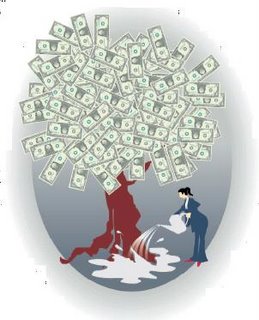 CG companies emerge winners with respect to efficient capital deployment Wondering where your money is going? Adjusted Return on Capital Employed (absolute figures) is a measure of profitability that reflects how much profits are being generated from the total capital employed in the business. The determination of Adjusted ROCE includes calculation of profits after tax and capital employed (difference between assets and current liabilities). It is a significantly reliable tool in the hands of investors that helps them to gauge corporate performance To put it simply, investors can measure how much return an entity is generating on the funds that are employed in it.
CG companies emerge winners with respect to efficient capital deployment Wondering where your money is going? Adjusted Return on Capital Employed (absolute figures) is a measure of profitability that reflects how much profits are being generated from the total capital employed in the business. The determination of Adjusted ROCE includes calculation of profits after tax and capital employed (difference between assets and current liabilities). It is a significantly reliable tool in the hands of investors that helps them to gauge corporate performance To put it simply, investors can measure how much return an entity is generating on the funds that are employed in it. Networth Stock, averred, “They are aiming at the production of 15 MMT by 2010 from 5 MMT presently. Also, the company has started ensuring availability of raw material supplies before going for expansion.” Indeed, ensuring raw material supply is of critical importance when there is a resource crunch. By 2015, the company plans to have a war chest of 30 MMT. Even SAIL is feeling the heat of the consolidation boiler. Medium-sized players like Jindal, Essar, Ispat and others have also announced more than Rs.300 billion for expansions. The plans look good, but are Indian players also playing the consolidation tune? The answer is yes, but consolidation is happening at a very slow pace currently. A case in point is the dragon zone, where the Indian players have a miniscule presence.
Networth Stock, averred, “They are aiming at the production of 15 MMT by 2010 from 5 MMT presently. Also, the company has started ensuring availability of raw material supplies before going for expansion.” Indeed, ensuring raw material supply is of critical importance when there is a resource crunch. By 2015, the company plans to have a war chest of 30 MMT. Even SAIL is feeling the heat of the consolidation boiler. Medium-sized players like Jindal, Essar, Ispat and others have also announced more than Rs.300 billion for expansions. The plans look good, but are Indian players also playing the consolidation tune? The answer is yes, but consolidation is happening at a very slow pace currently. A case in point is the dragon zone, where the Indian players have a miniscule presence. public sector style of functioning, marked by employees barely being able t stifle their yawn during working hours, to a really modern bank, competitive enough to make every other bank run hard for its money – it has been a long battle that SBI carried out quite admirably. Today, the company’s results are simply outstanding; gross NPAs have declined sharply from 11.95% in March 2002 to 3.88% in March 2006; and its capital adequacy has moved up by several notches to 11.88%, a figure that is comparable to the best banks across the globe. As of June 2006, over 3,372 branches were under the ambit of core banking; and internet banking is being provided at 3,544 branches covering 650,000 users. Interestingly,
public sector style of functioning, marked by employees barely being able t stifle their yawn during working hours, to a really modern bank, competitive enough to make every other bank run hard for its money – it has been a long battle that SBI carried out quite admirably. Today, the company’s results are simply outstanding; gross NPAs have declined sharply from 11.95% in March 2002 to 3.88% in March 2006; and its capital adequacy has moved up by several notches to 11.88%, a figure that is comparable to the best banks across the globe. As of June 2006, over 3,372 branches were under the ambit of core banking; and internet banking is being provided at 3,544 branches covering 650,000 users. Interestingly, nowadays seems to only bank on kids when it comes to advertising, and this time too, it delivers a power-packed performance! Cute kids are the flavour of the day. However, this ad not only depends on the cuteness quotient but combines it with a heart wringing storyline too. While the power idea is the 10/10 contest scholarship, the ad doesn’t miss on its product benefit ,which is its stain removing ability. While the brand personality of Surf Excel is visible through and through, the strong emotional factor, the clarity of communication and its high visual appeal work wonders for the concept. An extension of the winning campaign Daag achche hain commercials, this one may not be the best in the series but touches hearts for sure.
nowadays seems to only bank on kids when it comes to advertising, and this time too, it delivers a power-packed performance! Cute kids are the flavour of the day. However, this ad not only depends on the cuteness quotient but combines it with a heart wringing storyline too. While the power idea is the 10/10 contest scholarship, the ad doesn’t miss on its product benefit ,which is its stain removing ability. While the brand personality of Surf Excel is visible through and through, the strong emotional factor, the clarity of communication and its high visual appeal work wonders for the concept. An extension of the winning campaign Daag achche hain commercials, this one may not be the best in the series but touches hearts for sure.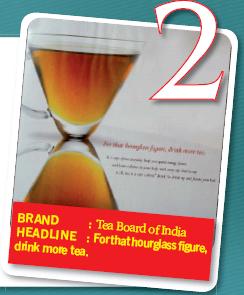 Someone rightly said, ‘Tea is liquid wisdom’ and according to this ad, it is the cup of life too. The power idea is to unshackle the myth of tea being a staid and boring drink, instead making young consumers aware that tea actually is a hip drink, which even helps you burn calories. In fact, the copy has perfect clarity on the tea’s positioning and relates its clinching benefit: 4-5 cups of tea everyday, helps you spend energy faster and that it is a ‘zero calorie drink’. The photograph displaying a cuppa of the hot brew, increases the visual appeal of the ad. The body copy further urges you to drink tea, and ‘flaunt that bod’. Now that’s what we call appealing to the target audience, in their lingo!
Someone rightly said, ‘Tea is liquid wisdom’ and according to this ad, it is the cup of life too. The power idea is to unshackle the myth of tea being a staid and boring drink, instead making young consumers aware that tea actually is a hip drink, which even helps you burn calories. In fact, the copy has perfect clarity on the tea’s positioning and relates its clinching benefit: 4-5 cups of tea everyday, helps you spend energy faster and that it is a ‘zero calorie drink’. The photograph displaying a cuppa of the hot brew, increases the visual appeal of the ad. The body copy further urges you to drink tea, and ‘flaunt that bod’. Now that’s what we call appealing to the target audience, in their lingo! a melody as innocuous as our national song could possibly provoke any measure of outrage; a forceful rethink proved to be on the cards as the supposed centenary of Bankimchandra Chattopadhyay’s Vande Mataram presented itself last week. I’m sure you’ve heard, seen and read plenty of the controversy already, weighed the pros and cons of the matter too – was the HRD Ministry correct in circulating an order to schools mandating a rendition of the song on Sept. 7;
a melody as innocuous as our national song could possibly provoke any measure of outrage; a forceful rethink proved to be on the cards as the supposed centenary of Bankimchandra Chattopadhyay’s Vande Mataram presented itself last week. I’m sure you’ve heard, seen and read plenty of the controversy already, weighed the pros and cons of the matter too – was the HRD Ministry correct in circulating an order to schools mandating a rendition of the song on Sept. 7; ous Honda communications, zeroing in on the ‘move up in life’ plank. The visual and body copy both have the brand personality of the Japanese carmaker, virtually stamped on them: ‘One simple decision states your arrival in life’, and of course, the decision is to drive home the swanky Honda City ZX, says the ad. The visual is simple yet attractive, showing a speeding Honda City ZX model on the road. The body copy also elaborates on how the sleek and aerodynamic style of the City ZX is backed by the most advanced technology... a clinching benefit for the brand?
ous Honda communications, zeroing in on the ‘move up in life’ plank. The visual and body copy both have the brand personality of the Japanese carmaker, virtually stamped on them: ‘One simple decision states your arrival in life’, and of course, the decision is to drive home the swanky Honda City ZX, says the ad. The visual is simple yet attractive, showing a speeding Honda City ZX model on the road. The body copy also elaborates on how the sleek and aerodynamic style of the City ZX is backed by the most advanced technology... a clinching benefit for the brand? proclaims Bollywood actor Hrithik Roshan in the latest promotion of the much hyped, upcoming Yash Raj film Dhoom-2. The movie promises to edify all that the original blockbuster Dhoom stood for and wow audiences with high voltage drama, death defying stunts and breathtaking visuals. The promos take you from speeding trains to rush hour traffic to cliff hanging sequences within seconds. While this is instant déjà vu for the fans of Dhoom, a section of you might be wondering, “Where are those bikes?” The Hayabusa 1300s and GSX R600s of Dhoom in fact captured the fascination of the youth and induced a sense of nomad biking fever in them. The movie was followed by an unprecedented surge in aspirational value for the motorbike. But it seems that the game ‘is’ over for those mean machines, at least in the Dhoom sequel. Let’s move on to the real world now.
proclaims Bollywood actor Hrithik Roshan in the latest promotion of the much hyped, upcoming Yash Raj film Dhoom-2. The movie promises to edify all that the original blockbuster Dhoom stood for and wow audiences with high voltage drama, death defying stunts and breathtaking visuals. The promos take you from speeding trains to rush hour traffic to cliff hanging sequences within seconds. While this is instant déjà vu for the fans of Dhoom, a section of you might be wondering, “Where are those bikes?” The Hayabusa 1300s and GSX R600s of Dhoom in fact captured the fascination of the youth and induced a sense of nomad biking fever in them. The movie was followed by an unprecedented surge in aspirational value for the motorbike. But it seems that the game ‘is’ over for those mean machines, at least in the Dhoom sequel. Let’s move on to the real world now. Chughtai’s short story ‘Gharwali’ and starring Kareena Kapoor and Aamir Khan, ‘Lajjo’ will commence filming in November 2006. It is a movie that derides the institution of marriage – like the recently released KANK – and that renegotiates the manwoman relationship, one where the woman philanders. Now, in an uphill progression, the Indian audience is coming around to the idea of paying to see their favourite stars in movies that are experimental; that lack forced song-and-dance sequences (oft en times in the rain) and without hackneyed dialogue (of course ,filmmakers still feel compelled to include at least one juicy dance number).
Chughtai’s short story ‘Gharwali’ and starring Kareena Kapoor and Aamir Khan, ‘Lajjo’ will commence filming in November 2006. It is a movie that derides the institution of marriage – like the recently released KANK – and that renegotiates the manwoman relationship, one where the woman philanders. Now, in an uphill progression, the Indian audience is coming around to the idea of paying to see their favourite stars in movies that are experimental; that lack forced song-and-dance sequences (oft en times in the rain) and without hackneyed dialogue (of course ,filmmakers still feel compelled to include at least one juicy dance number). e to an oversupply in Tier II cities. There could be marginal decline in value in certain areas owing to oversupply, and without development being done in these areas, people have started doubting (the boom in the sector).” Additionally, around the festival time, one can look forward to the jumbo DLF IPO, which was the first to be launched in July, but got delayed owing to plummeting markets. DLF plans to raise around Rs.110 billion to armour its mega projects in the realty and hospitality sector. Many trade pundits believe that whatever be the size of DLF IPO, it is most likely to be oversubscribed. Nevertheless, the IPO will give an interesting insight into the current sentiments of investors in the real estate market.
e to an oversupply in Tier II cities. There could be marginal decline in value in certain areas owing to oversupply, and without development being done in these areas, people have started doubting (the boom in the sector).” Additionally, around the festival time, one can look forward to the jumbo DLF IPO, which was the first to be launched in July, but got delayed owing to plummeting markets. DLF plans to raise around Rs.110 billion to armour its mega projects in the realty and hospitality sector. Many trade pundits believe that whatever be the size of DLF IPO, it is most likely to be oversubscribed. Nevertheless, the IPO will give an interesting insight into the current sentiments of investors in the real estate market. If global behemoths like Wal-Mart and Carrefour are planning to come to town, the RPG group – with its Rs.200 crores planned investment and long creditworthy Spencers brand – might be the least of worries they’ll have to face. The biggest headache, a debilitating one in all probability, for these international leaders would definitely be Mukesh Ambani, who plans to invest an eye popping Rs.25,000 crores, and employ a soul stopping one million employees over the next few years on retail. Reliance could well be the Indian Wal-Mart. And I’ve not even started talking about companies like Pantaloon, which have already started consolidating their presence in the retail sector. In fact, even companies like Siyaram – one of the few brands that was able to give Raymonds a run for its money – are planning to introduce retail outlets across the nation.
If global behemoths like Wal-Mart and Carrefour are planning to come to town, the RPG group – with its Rs.200 crores planned investment and long creditworthy Spencers brand – might be the least of worries they’ll have to face. The biggest headache, a debilitating one in all probability, for these international leaders would definitely be Mukesh Ambani, who plans to invest an eye popping Rs.25,000 crores, and employ a soul stopping one million employees over the next few years on retail. Reliance could well be the Indian Wal-Mart. And I’ve not even started talking about companies like Pantaloon, which have already started consolidating their presence in the retail sector. In fact, even companies like Siyaram – one of the few brands that was able to give Raymonds a run for its money – are planning to introduce retail outlets across the nation.More IIPM-Sites:-
http://iipmpublication.blog.co.uk/
http://iipmeditorial.blog.co.uk/
http://iipmpublicationeditorial.blog.co.uk/
http://iipmmanagement.blog.co.uk/
http://iipmeditorialandpublication.blog.co.uk/
http://spaces.msn.com/iipm-best-edition/
http://spaces.msn.com/iipm-bestarticle-iipm/
http://spaces.msn.com/iipm-best-publication/
http://spaces.msn.com/iipmedi-iipm/
http://spaces.msn.com/iipm-article-pub-iipm/
http://iipmbestarticle.blogspot.com/
http://iipm-best.blogspot.com/
http://iipmnewsarticles.blogspot.com/
http://iipmarticleiipmeditorial.blogspot.com/
http://iipm-bestfaculty.blogspot.com/
http://iipmpublicationedu.blog.co.uk/
http://iipmbestfaculty.blog.co.uk/
http://iipmnewdelhi.blog.co.uk/
http://iipmdelhi.blog.co.uk/
http://iipmeditorialiipm.blog.co.uk/
http://spaces.msn.com/iipm-publicationiipm/
http://spaces.msn.com/iipm-art-pub-iipm/
http://spaces.msn.com/iipm-editorial/
http://spaces.msn.com/iipm-publication/
http://spaces.msn.com/iipm-edi-publication/
http://iipmarticlepublicationiipm.blogspot.com/
http://iipm-newsarticle.blogspot.com/
http://iipmeditorial-iipm.blogspot.com/
http://iipmpressarticle.blogspot.com/
http://iipm-press.blogspot.com/
 uld have over 550 million people under the age of 20, making it a vast playground for kids and teen retailers. No wonder, in India the Walt Disney Company has decided to launch its range of toys, clothing etc designed around the popular Disney show “Power Rangers” in collaboration with Shopper’s Stop, Archies, Funskool etc. The wonder of it all is that those are not just the foreign brands and chains, but Indian retail chains too, which are gearing up for a huge expansion plan. No one wants to miss the opportunity of growth that India is offering now.
uld have over 550 million people under the age of 20, making it a vast playground for kids and teen retailers. No wonder, in India the Walt Disney Company has decided to launch its range of toys, clothing etc designed around the popular Disney show “Power Rangers” in collaboration with Shopper’s Stop, Archies, Funskool etc. The wonder of it all is that those are not just the foreign brands and chains, but Indian retail chains too, which are gearing up for a huge expansion plan. No one wants to miss the opportunity of growth that India is offering now. s the twin towers came hurtling down like a stack of cards on 9/11, so did the lives of those caught in the crosshairs of that fateful day, as has been chronicled ad infnitum. The affected meander through life with eyes wide open and minds firmly shut, distraught with the turn of events. And in what can only be termed a volte-face on conventional coverage of the horrific happenings, Ken Kalfus makes one peruse the ponderings of twisted souls deriving a perverse sense of pleasure from this titanic tragedy, in A Disorder Peculiar to the Country. Heaven hath no rage like love to hatred turned, nor hell a fury like a woman scorned.
s the twin towers came hurtling down like a stack of cards on 9/11, so did the lives of those caught in the crosshairs of that fateful day, as has been chronicled ad infnitum. The affected meander through life with eyes wide open and minds firmly shut, distraught with the turn of events. And in what can only be termed a volte-face on conventional coverage of the horrific happenings, Ken Kalfus makes one peruse the ponderings of twisted souls deriving a perverse sense of pleasure from this titanic tragedy, in A Disorder Peculiar to the Country. Heaven hath no rage like love to hatred turned, nor hell a fury like a woman scorned. lament about skyhigh petrol prices. Ascending numbers at the gas pump have become a horrifying fixture in the economic thinking of consumers worldwide except the lucky chaps in oil producing nations, where a full tank can still be had for small change. Unfortunately, this does not apply to the two leading economic locomotives in Asia – China and India. Both nations are almost fully dependent on oil imports to keep the cars honking and the industry humming. Projects to broaden the use of alternative fuels have not ascended above the line of marginality yet. Not that nobody was trying hard. Biofuel production is becoming a priority fast.
lament about skyhigh petrol prices. Ascending numbers at the gas pump have become a horrifying fixture in the economic thinking of consumers worldwide except the lucky chaps in oil producing nations, where a full tank can still be had for small change. Unfortunately, this does not apply to the two leading economic locomotives in Asia – China and India. Both nations are almost fully dependent on oil imports to keep the cars honking and the industry humming. Projects to broaden the use of alternative fuels have not ascended above the line of marginality yet. Not that nobody was trying hard. Biofuel production is becoming a priority fast.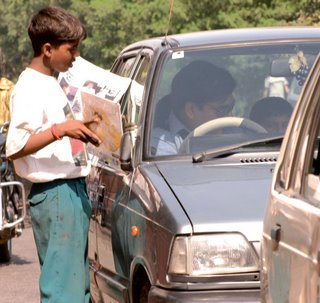 Delhi at a traffic signal junction, people instantly look for cover the moment they come out into the open. For the calculated moments that those bright spots of lights make caravans wait, some feet spring to life. In their hands they carry books and periodicals celebrating the bold and the beautiful. Displaying them in the best possible manner, people waiting for the green light are implored to dig into their pockets. Combining suitably the elements of begging and marketing, these market beggars with their sun-baked and charred faces seemingly do not feel the heat. Ironically, the periodicals that they carry might have a columnist spewing venom at the government’s ignorance to child labour issues.
Delhi at a traffic signal junction, people instantly look for cover the moment they come out into the open. For the calculated moments that those bright spots of lights make caravans wait, some feet spring to life. In their hands they carry books and periodicals celebrating the bold and the beautiful. Displaying them in the best possible manner, people waiting for the green light are implored to dig into their pockets. Combining suitably the elements of begging and marketing, these market beggars with their sun-baked and charred faces seemingly do not feel the heat. Ironically, the periodicals that they carry might have a columnist spewing venom at the government’s ignorance to child labour issues.  onlookers globally. Another cutting philosophy supporting withdrawal of governments from investing in space travel, is that the money could be better spent on social development; more so as the oft touted claim – that other planets would provide access to huge amounts of resources which will benefit humanity – has never seen the light of space! And while critics portray the future foray as a repeat of colonial expeditions of the 15th & 16th century, the democratisation of space is not possible without reducing the cost of launches, which would necessarily come through private participation.
onlookers globally. Another cutting philosophy supporting withdrawal of governments from investing in space travel, is that the money could be better spent on social development; more so as the oft touted claim – that other planets would provide access to huge amounts of resources which will benefit humanity – has never seen the light of space! And while critics portray the future foray as a repeat of colonial expeditions of the 15th & 16th century, the democratisation of space is not possible without reducing the cost of launches, which would necessarily come through private participation. recently in Spain, a charging bull happened to gore a man in the legs rendering bruises, sprains and worse. Seems the Spaniards had finally been bullied enough by these bossy bovines! Since 1924, a total of 13 people have been killed till date where the worst injury this year came when a man was left partially paralysed. As a result of all this and for the protection of animal rights, the regional parliament of Catalonia is all set to impose a ban on bullfights. A hit right on the bull’s eye, isn’t it?
recently in Spain, a charging bull happened to gore a man in the legs rendering bruises, sprains and worse. Seems the Spaniards had finally been bullied enough by these bossy bovines! Since 1924, a total of 13 people have been killed till date where the worst injury this year came when a man was left partially paralysed. As a result of all this and for the protection of animal rights, the regional parliament of Catalonia is all set to impose a ban on bullfights. A hit right on the bull’s eye, isn’t it?AVIVA IS TAKING A RISK BY PAYING TOO HEFTY AN AMOUNT TO BUY AMERUS
When escapades are eternally accursed, no matter what you do, there’s lit tle that can effect a good outcome. Right from Aviva’s infamous beginnings in 2000 by the merger of the fraudulent CGU with Norwich Union to its overhyped $31.4 billion bid for UK’s insurance giant Prudential in March 2006, its credentials have always been doubted! But the wounded tiger is on the prowl and has its eyes currently set on the USbased life assurer, AmerUS. Despite having just $2.52 billion cash in its kitty (as on December 31, 2005), it has declared a consideration of $2.9 billion for the buy on July 13. Excluding debt and internal accruals, it has raised $1.66 billion through a share placement for the acquisition.
tle that can effect a good outcome. Right from Aviva’s infamous beginnings in 2000 by the merger of the fraudulent CGU with Norwich Union to its overhyped $31.4 billion bid for UK’s insurance giant Prudential in March 2006, its credentials have always been doubted! But the wounded tiger is on the prowl and has its eyes currently set on the USbased life assurer, AmerUS. Despite having just $2.52 billion cash in its kitty (as on December 31, 2005), it has declared a consideration of $2.9 billion for the buy on July 13. Excluding debt and internal accruals, it has raised $1.66 billion through a share placement for the acquisition.
Richard Harvey, Group CEO, Aviva states the deal “provides the platform for significant profitable growth.” With 77 m illion Americans set to hit retirement age shortly, the deal looks positive in the US long term savings market. But analysts are questioning the wisdom behind the move as share prices slipped to a 7-month low to close at 691 pence on July 16, 2006. Kevin Ryan, analyst, ING critically comments, “They have gone for it (AmerUS) as Prudential was not available.” According to the concept of European Embedded Value (EEV) – a measure of a life insurer’s worth to a shareholder, Aviva is paying 1.9 times EEV for AmerUS, which is much more compared to the 1.6 times EEV that was paid by France’s AXA for Winterthur. So is Aviva paying too much? Well, certainly they are; but then perhaps they feel there won’t be a third time. Now wait! Is Aviva reinsured?
illion Americans set to hit retirement age shortly, the deal looks positive in the US long term savings market. But analysts are questioning the wisdom behind the move as share prices slipped to a 7-month low to close at 691 pence on July 16, 2006. Kevin Ryan, analyst, ING critically comments, “They have gone for it (AmerUS) as Prudential was not available.” According to the concept of European Embedded Value (EEV) – a measure of a life insurer’s worth to a shareholder, Aviva is paying 1.9 times EEV for AmerUS, which is much more compared to the 1.6 times EEV that was paid by France’s AXA for Winterthur. So is Aviva paying too much? Well, certainly they are; but then perhaps they feel there won’t be a third time. Now wait! Is Aviva reinsured?
For Complete IIPM - Article, Click on IIPM-Editorial Link
Source:- IIPM-Business and Economy, Editor:- Prof. Arindam Chaudhuri - 2006
 elding robbers with eye-patches, bandanas and shrieking parrots atop their hands, the perpetrators of modern sea piracy are perhaps more menacing. And the areas that they threaten equals a potential two thirds of the globe! As for the exactitude, the second busiest sea route – the Indian Ocean – is the most vulnerable. The International Maritime Bureau contends that the ‘maximum danger area’ stretches from the Yemeni to the Somali coast, and further from the Strait of Malacca to the South China Sea.
elding robbers with eye-patches, bandanas and shrieking parrots atop their hands, the perpetrators of modern sea piracy are perhaps more menacing. And the areas that they threaten equals a potential two thirds of the globe! As for the exactitude, the second busiest sea route – the Indian Ocean – is the most vulnerable. The International Maritime Bureau contends that the ‘maximum danger area’ stretches from the Yemeni to the Somali coast, and further from the Strait of Malacca to the South China Sea.Read More IIPM-Blogs:-

